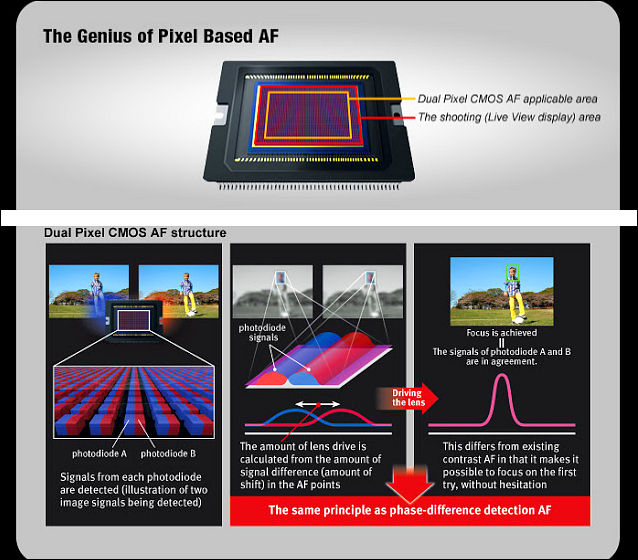
-
More info
"Each pixel on the EOS 70D camera's sensor consists of two independent photodiodes that function both as imaging points and as individual phase-difference AF sensors. When the shutter button is pressed, parallax images on each photodiode of the pixel are detected, the amount of lens drive is calculated to correct the amount of shift in the AF points, and AF is achieved nearly instantaneously. During image capture, the same two photodiodes record the image and output as a single pixel. By placing approximately 40.3 million photodiodes on the camera's sensor, two per pixel, this caliber of AF is possible on approximately 80% of the image plane, vertically and horizontally. When the image or video clip is being captured, the CMOS sensor behaves as it always has with EOS SLR cameras, unimpeded by the dual photodiodes and recording each individual pixel with virtually no loss of detail or sharpness."

http://www.usa.canon.com/cusa/consumer/standard_display/daf_technology
Canon’s newly-developed Dual Pixel CMOS AF is an innovative new image-plane phase-detection AF technology that employs a CMOS sensor on which all of the effective pixels are able to perform both imaging and phase-detection AF simultaneously. Each individual pixel (the smallest structural unit capable of outputting an image signal) on the CMOS sensor incorporates two independent photodiodes (elements that transform light into electrical signals) which output signals that can be used for both imaging and the phase-detection AF. When using the EOS 70D Digital SLR camera’s Live View function, the technology enables autofocusing with ease, flexibility, speed and accuracy similar to shooting through the viewfinder, enabling sharp focus to be obtained across a wide shooting area1 through phase-detection AF2 until final focus is achieved. Compared with earlier generations of Canon’s image-plane phase-detection AF3, Dual Pixel CMOS AF realizes shorter focusing times, outstanding tracking performance and smoother autofocusing during video shooting. And, because Live View shooting can be used in a manner similar to using the camera’s viewfinder, the fast and smooth AF performance allows users to concentrate more attention on the subject and composing the photo when shooting.
Compared with the EOS Rebel SL1, which employs Hybrid CMOS AF II, the EOS 70D Digital SLR camera (scheduled to go on sale in September 2013), which is the first camera to feature Dual Pixel CMOS AF, not only achieves AF speed that is approximately 30 percent faster but also delivers improved Movie Servo AF tracking for continuously smooth focusing during video shooting, even when filming quickly moving subjects.

 monit2.jpg638 x 560 - 85K
monit2.jpg638 x 560 - 85K -
At the core of the 70D's modifications is what Canon's calling Dual Pixel CMOS AF. Essentially, the sensor includes twice the number of pixels in a (very successful) attempt to improve focusing. There are 40.3 million photodiodes on the sensor, and when they're all working together, "it's like 20 million people tracking the focus with both eyes," as Canon explains. The result is camcorder-like focusing for both stills and video, when you're shooting in live view mode. During our test with a pre-production sample, the device performed phenomenally, adjusting focus instantaneously when snapping stills, and quickly but gradually when recording video. Join us after the break for a closer look
This is just some weird explanation.
Howdy, Stranger!
It looks like you're new here. If you want to get involved, click one of these buttons!
Categories
- Topics List23,992
- Blog5,725
- General and News1,354
- Hacks and Patches1,153
- ↳ Top Settings33
- ↳ Beginners256
- ↳ Archives402
- ↳ Hacks News and Development56
- Cameras2,367
- ↳ Panasonic995
- ↳ Canon118
- ↳ Sony156
- ↳ Nikon96
- ↳ Pentax and Samsung70
- ↳ Olympus and Fujifilm101
- ↳ Compacts and Camcorders300
- ↳ Smartphones for video97
- ↳ Pro Video Cameras191
- ↳ BlackMagic and other raw cameras116
- Skill1,960
- ↳ Business and distribution66
- ↳ Preparation, scripts and legal38
- ↳ Art149
- ↳ Import, Convert, Exporting291
- ↳ Editors191
- ↳ Effects and stunts115
- ↳ Color grading197
- ↳ Sound and Music280
- ↳ Lighting96
- ↳ Software and storage tips266
- Gear5,420
- ↳ Filters, Adapters, Matte boxes344
- ↳ Lenses1,582
- ↳ Follow focus and gears93
- ↳ Sound499
- ↳ Lighting gear314
- ↳ Camera movement230
- ↳ Gimbals and copters302
- ↳ Rigs and related stuff273
- ↳ Power solutions83
- ↳ Monitors and viewfinders340
- ↳ Tripods and fluid heads139
- ↳ Storage286
- ↳ Computers and studio gear560
- ↳ VR and 3D248
- Showcase1,859
- Marketplace2,834
- Offtopic1,320





